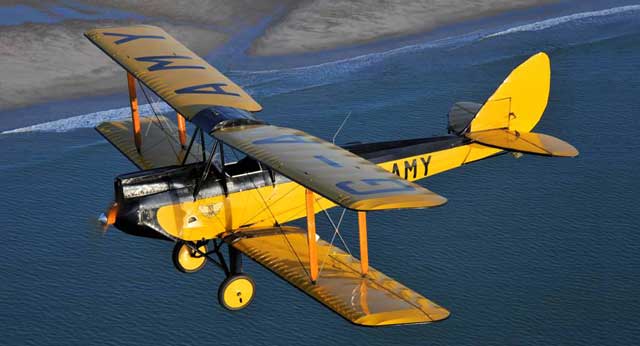Pilots, watch what you eat
The right foods for flight
by Alton K. Marsh
Everything pilots eat is pretty much wrong. We’re eating things that put us to sleep when in the air, and things that keep us awake when we need to rest for the next day. That’s the finding of Paula Kraft, owner of Tastefully Yours in Atlanta, which prepares foods for crew members and passengers of business jets. She uses in-flight nutritionists to pick the right foods for the rigors of travel.
“The flight crew has a grueling job. It takes a huge toll on the body. If they don’t put in preventative measures to counterbalance all the effects of travel—going between time zones, eating in unfamiliar places at odd times—then they will get sick more often. They’re tired, draggy, exhausted, have fatigue, and have less of a response time,” she said. Here are some valuable tips.
Power drinks are not helping. “Any of your power drinks are called crash-and-burn. You’ll get an instant push of energy, but you’re going to come down really hard. Caffeinated drinks will have the same effect.” When you come down, you’ll have greater fatigue and therefore poorer judgment. Just drink water. Lots of it.
Everybody thinks power bars and granola bars are healthy. “Because of the amount of carbohydrates they bring you up, and instantly bring you down,” she said.
Potato chips are also high in carbs. “If you are going to be flying in the middle of the night, chips are the wrong way to go. Eat high-protein items, vegetables, and fatty items. The fatty items will keep you awake.”
At breakfast, no croissants or home-fried potatoes. Whole- grain toast digests slower and supports you longer. Meat and vegetables are also good. Avoid a yogurt parfait with fruit, granola, berries, and nuts. You will have an energy release but it will drop off suddenly. Oatmeal is high in carbohydrates and will not sustain you for the day. You’ll crave sweets a few hours later. Best bet? An egg-white omelet loaded with vegetables, whole-grain toast, and chicken sausage rather than pork sausage. Avoid the cheese tray because it will make you sleepy. Lunch? Grilled fish or chicken salad.
Email [email protected].
Piper celebrates 75 years
Hosts an anniversary celebration in Vero Beach
By Mike Collins
There wasn’t a cake—although there were cupcakes aplenty as Piper Aircraft Inc. hosted a celebration of its seventy-fifth anniversary at its Vero Beach, Florida, headquarters and factory in November. Hundreds of people were on hand and 84 aircraft—including Piper products representing the company’s lineage back to its first model, the J–3 Cub—flew in.
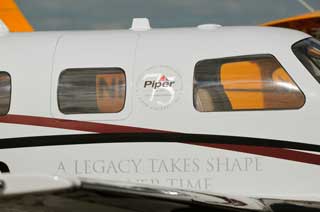 Bill Waldron of Morristown, New Jersey, flew down with three friends for the weekend in his 1965 Piper Comanche 400. He said he’s visited the Piper factory several times and wanted to be there for the anniversary celebration. “I figured I’d fly my Comanche back to its home—even though it was made in Lock Haven,” he laughed. David Hockin of Huntsville, Ontario, Canada, had to leave his 1947 J–3 behind. The airplane, with a Continental O-200 engine and straight floats, had just been put away for the winter.
Bill Waldron of Morristown, New Jersey, flew down with three friends for the weekend in his 1965 Piper Comanche 400. He said he’s visited the Piper factory several times and wanted to be there for the anniversary celebration. “I figured I’d fly my Comanche back to its home—even though it was made in Lock Haven,” he laughed. David Hockin of Huntsville, Ontario, Canada, had to leave his 1947 J–3 behind. The airplane, with a Continental O-200 engine and straight floats, had just been put away for the winter.
Visitors were able to tour Piper’s manufacturing facility, and hear a presentation on the company’s past by Piper’s historian, Roger Peperell.
The venerable manufacturer is not resting on its laurels, however. Piper President and CEO Simon Caldecott, who has led Piper for the past 13 months, said that one of his goals is to re-engage Piper in the training market. “We recognized we were missing a big opportunity. Piper Aircraft’s heritage is in training aircraft—the Piper Cub is a great example of that. The Cub trained 80 percent of the pilots during World War II, and today approximately 28 percent of people learn to fly in a Piper product,” he said.
Piper is updating its training aircraft—the Seminole twin and Archer single—with Garmin G1000 glass-cockpit avionics suites, beginning with 2013 deliveries. FIT, a frequent Piper customer that most recently purchased 12 new Pipers five years ago, will take delivery of eight new Piper Archer TX aircraft next year, and has options on 16 additional Archer TX or Seminole TX trainers for future delivery.
Email [email protected].
The other side of the fence
Encouraging the next generation of pilots
By Kevin Garrison
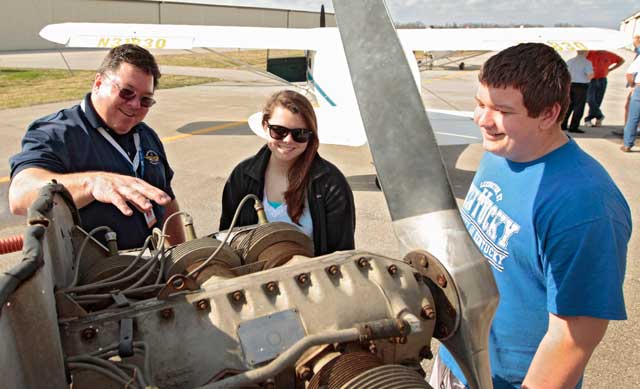
The Kentucky Institute for Aerospace Education (KIAE) and other organizations like it are working to help solve a problem that aviation industry groups have been wrestling with for some time. It’s no secret that the pilot population is aging and flight schools are in constant need of new students.
Started in a T-hangar with an airplane project provided by the Build-a-Plane organization, the high school students and volunteer adults at KIAE have grown to seven airplane projects, a flight training program, and a mechanic training program.
Founding teacher Dr. Tim Smith started his program that later evolved into KIAE from the bottom up, and the idea soon grew from a single school to a network of 16 Kentucky high schools—with many more on the way, including high schools in other states.
KIAE provides tool kits and resources to schools in the network at no charge. These include flight kits, aircraft maintenance resources, and engineering materials.
The flight training program is largely free. Students rebuilt a Cessna 152 they fly and maintain. Volunteers act as flight instructors, to keep costs close to zero. Money for fuel comes from additional fundraising and contributions. 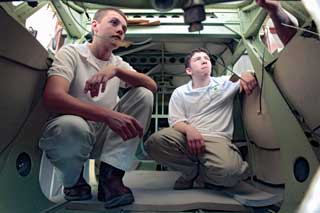
Statewide, many other aircraft and aerospace building and educational projects are under way, being accomplished by member schools with their volunteer adult helpers. In addition, students at KIAE work with the University of Kentucky and other colleges on aerospace engineering projects, as well as with NASA.
Other programs of this type exist, but they most often were planned and started from the top down. They are begun by an influx of money, followed by the hope that students will sign up. Another facet of most other programs is that they are specifically training students for a single career in a single area. The KIAE model offers a wide variety of experiences that young people can try out.
Kevin Garrison, a retired airline pilot, volunteers with the Kentucky Institute for Aerospace Education.
Pay it forward
Volunteers and their efforts are the heart of the organization. Larry Mooney is a great example. An experienced aircraft mechanic and pilot, Mooney is at the airport every Saturday instructing the kids in everything from TIG welding to fabric work to engine overhaul. Every minute the students spend in the shop is logged toward their airframe and powerplant certificate.
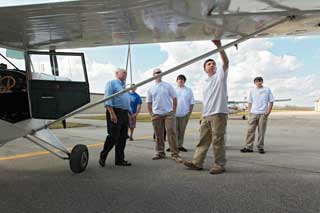 While the training is at almost no cost to the students, KIAE is not a free ride. The students spend three years of weekly work in the hangar and the classroom before they get a shot at the flying program. The ones who get that far have earned their flight training spot in a very special way, and have a special appreciation for the training.
While the training is at almost no cost to the students, KIAE is not a free ride. The students spend three years of weekly work in the hangar and the classroom before they get a shot at the flying program. The ones who get that far have earned their flight training spot in a very special way, and have a special appreciation for the training.
These students show up for their first flying lesson after having already built one or more aircraft. They work their way through classroom labs, model aircraft, flying simulators, model rocketry, engineering seminars, and countless hours of hangar talk before they take their first hour of dual flight instruction.
KIAE’s ability to give the students an early exposure to all facets of aviation—and to allow them to decide what they don’t like—is as valuable as finding out what they do like. It is much better to find out you don’t really want to be a professional pilot in high school, not after signing up for a 10-year military commitment or dropping huge money to attend a private aviation college.
Many students lean toward the engineering side of things. At KIAE, one of the volunteer adults helped design the spacecraft of the moon race for NASA and lives nearby as a retired professor. He is now offering interested students a free class on spacecraft design and construction.
What can experienced adults who have had a career in aviation do to move things along for these ambitious young people? Volunteer your time to pass along some of that hard-earned knowledge. You don’t need millions of dollars of funding, a huge building, and a full-time professional staff to motivate and teach young people. All that is really needed are a mentor, an interested student, and time.
Aircraft donations fuel future of GA
A tale of two donors
By Jim Moore and Sarah Brown
J. Lloyd Huck had a dilemma. A day after promising his American Champion Champ to AOPA, the second aircraft he was to donate, the veteran pilot got an unexpected call. A buyer had come forward, and placed a deposit—Huck made short work of that situation, closing the deal and donating the proceeds to the AOPA Foundation.
The very generous donation (about $75,000) will go a long way toward supporting the freedom to fly that Huck fought for, in more ways than one, during an aviation career that began during World War II flying the B–17 and B–29. 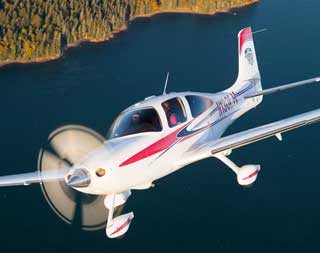
Huck’s general aviation career spanned decades, but time and health finally caught up with him this year, just short of his goal of flying until he celebrated 90 years in July. Huck had already donated one of his personal aircraft: the AOPA 2009 Let’s Go Flying Sweepstakes Cirrus SR22. He bought the Champ, which he was able to fly under Light Sport rules and extended his time in the cockpit by about three years. He believes that his latest donation also will serve an important purpose by supporting the foundation.
Jack Williams bought his 1988 Mooney PFM from the factory in 1989, a month after he earned his private pilot certificate in a Cessna 152. He and his wife, Ellyn, who earned her private pilot certificate a couple years later, flew the Porsche-powered airplane across the country so many times that Williams said he’s lost count.
“She’s efficient, she’s fast, we’ve really enjoyed her,” Williams said of the Mooney, which was reengined with a 280-horsepower Continental 520 in 2004. After 23 years and almost 3,700 flying hours, they considered selling the Mooney, and opting for an airplane that would allow them to slow down and fly a little lower.
As they began the search for a new airplane, the couple considered their options for selling the Mooney.
“It’s not an airplane that wants to be parked sitting with a ‘For Sale’ sign on its propeller,” he said. Then, when Williams was looking on the AOPA Foundation website at ways to give to the organization, he noticed a mention that one could donate an airplane. “It just seemed to me it was a good way to optimize its value all around,” he explained. “If the AOPA Foundation could put it to good use actually using the airplane, that could be great.” And if the organization decides to sell it, he added, it is in a much better position to optimize the yield of the sale.
Test Pilot By Barry Schiff
- What is the world's shortest scheduled airline flight (in terms of time and distance)?
- An instrument-rated pilot is flying in actual IFR conditions in Class G airspace and is not communicating with air traffic control. He should squawk which of the following codes on his transponder?
a) 1200
b) 3100
c) 5100
d) a discrete code - The Ninety Nines, the largest international organization of women pilots, used to conduct an annual transcontinental air race for women pilots. What famous personality dubbed that race the Powder Puff Derby?
- From reader Brian Schiff: What is the difference between spoilers and speed brakes?
- True or False: One or more U.S. airlines operated a supersonic transport (an SST) in scheduled passenger service within the United States.
- Why might jogging reduce a pilot's tolerance for high Gs?
- From reader John Schmidt: Why did director Tony Scott suddenly and unexpectedly write a $25,000 check and hand it to the captain of the USS Enterprise while filming Top Gun aboard the aircraft carrier?
- The most unfavorable weather associated with a low-pressure system is most often found in the _______ quadrant.
a. northeast
b. southeast
c. southwest
d. northwest
See answers below >>
Fuel from plastics to be used on intercontinental flight
Australia businessman Jeremy Rowsell hopes to fly a diesel-powered Cessna 182 from Australia to London on “Wings of Waste” using fuel made from plastics that can no longer be recycled. The fuel, which meets car and truck specifications, has never been tested on an aircraft. The fuel will be made by Cynar in Portlaoise, Ireland. It will be positioned along a 10,000-mile route from Sydney to London by his crew. Cynar CEO Michael Murray said his company sells the technology to make the fuel to corporations wanting to rid themselves of plastics that are at the end of their lives and can no longer be recycled. The plastic is heated and the fumes are then distilled into fuel. It takes one ton of end-of-life plastics to make 185 gallons of diesel fuel plus 53 gallons of gasoline and 26 gallons of kerosene. Murray said he has a quarter-billion dollars’ worth of orders for the technology over the next five years. The cost of the fuel is 10 percent less than fuel costs in the market. —AKM
Why donate
The AOPA Foundation’s airplane donation program, like many organizations’ car donation programs, allows a donor to bypass the hassle of selling and gain a tax benefit, while contributing to a cause. “The AOPA Foundation is in an ideal position to work with aircraft owners because we know the market,” said Stephanie Kenyon, AOPA Foundation vice president of strategic philanthropy.
When the AOPA Foundation receives an airplane, it may choose to keep it for staff transportation or training, or in the case of the 2009 Cirrus SR22 that Lloyd Huck donated, give it away as a sweepstakes airplane. The organization could also sell the airplane; in those cases, the proceeds go toward supporting the AOPA Foundation’s goals of improving GA’s safety, preserving and improving community airports, growing the pilot population, and supporting the good work being done through GA. Owners can start the process of donating an airplane on the AOPA Foundation website.
“It’s always special when someone like Lloyd or Jack and Ellyn gives us an important part of their lives,” said AOPA Foundation President Bruce Landsberg. “Pilots form a bond with our aircraft, and the AOPA Foundation is most appreciative.”
Jet industry ponders future at Orlando
News from NBAA
Once a year, a thousand companies and 20,000 to 30,000 people meet at the National Business Aviation Association convention to view new products, and assess the state of the aviation industry in the process. The market remains flat, but economic surveys suggested things will look much better in two to four years. 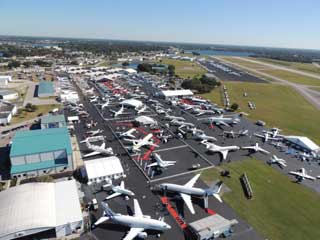
Beechcraft Corporation drew the greatest attention when company officials said they must cease warranty coverage (but will continue to make parts) for the 150 Hawker 4000 and Premier 1A jets, out of a fleet of 36,000 products in the field. But there was positive news, too. The company is not only supporting its propeller aircraft, it is planning new models. There will be something to bridge the gap between the Bonanza and Baron, and a couple of new, as-yet-undefined King Air models. The talk of the convention was about its single-engine turboprop that is basically a Premier jet fuselage stretched to carry eight to 11 passengers at 300 knots out of rough fields. A monster cargo door, winglets, and a T-tail complete the design.
Cessna’s big news was improvements to the Sovereign, the airplane that is so successful that its tail and wings (with modifications) were chosen for the new $14.9 million Latitude announced in 2011. The $17.8 million Sovereign has winglets, new Pratt & Whitney PW306D engines that boost range by 150 nautical miles (to more than 3,000 nm), autothrottles, and the Garmin G5000 avionics suite. Cessna decided to give up on the name, “Citation TEN,” and just call it the Citation X. It is the fastest business jet in the world.
Dassault Falcon Jet said it will offer a 2000LXS based on its 2000LX but lighter and equipped with a three-screen Honeywell Easy II cockpit.
The convention mood was marked by modest steps and modifications rather than stop-the-presses news—just as you might expect in the midst of an economic plague. Forecasts presented in Orlando indicate the good times will return by 2017. —AKM
Test Pilot Answers
- Loganair's two-minute, 1.5-nm flight between the islands of Westray and Papa Westray, two of the Orkney Islands in northern Scotland. View the entire flight online.
- (a) Controllers observing the transponder code will not know or care that the pilot is operating IFR in uncontrolled airspace.
- Will Rogers, an American cowboy, humorist, social commentator, and motion-picture actor, was one of the world's most famous celebrities of the 1920s and 1930s. Also an aviation advocate, he was killed in the crash of an airplane piloted by famed pilot Wiley Post.
- Spoilers are deployable surfaces designed primarily to spoil or kill lift (although they usually create some drag in the process). Speed brakes are surfaces designed primarily to produce drag.
- True. Using its own crews, Braniff International Airways operated the Concorde subsonically between Dallas/Fort Worth and Washington, D.C., in 1979 and 1980, but it was a financial disaster. Air France and British Airways operated the remainder of the flights to Paris and London at more than Mach 2.0.
- Jogging tends to lower blood pressure, which can reduce high-G tolerance.
- Scott needed the carrier turned to improve backlighting, but the captain advised that such maneuvering would cost the Navy $25,000. The rest is history, and the resultant footage was used during the film's stunning opening scene.
- (a) Also, low-pressure (or cyclonic) areas typically travel across the United States at about 500 or more statute miles per day.
Free flights for women and girls
Women of Aviation Worldwide Week 2013 to focus on aerospace
By Jill W. Tallman
March 4 through 10, 2013, is the date of the upcoming Women of Aviation Worldwide Week, and organizers say this year’s event will focus on opportunities for women in the aerospace industry. The theme ties in with the fiftieth anniversary of the first female flight in space, conducted by Russian astronaut Valentina Tereshkova on June 16, 1963.
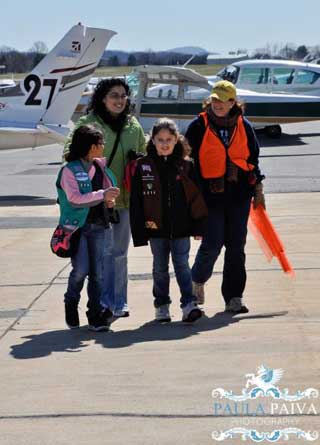 Free flights for women and girls, static displays at airports, and special guests are planned at numerous locations in the United States, Canada, and Europe.
Free flights for women and girls, static displays at airports, and special guests are planned at numerous locations in the United States, Canada, and Europe.
“No country harbors as many female astronauts as the United States does,” the nonprofit Institute for Women of Aviation Worldwide said on its website. “The goal is to welcome a female astronaut at each major U.S. event because…most astronauts are first, pilots. What could be a more exciting inspiration for a young woman to earn a pilot license?”
Victoria Neuville, team leader for U.S. events, said her goal is to have at least one event—called Fly It Forward—in each of the 50 states.
Neuville organized Fly It Forward events at Frederick Municipal Airport in Frederick, Maryland—AOPA’s home airport—in 2011 and 2012. Frederick Municipal earned the title of Most Female-Friendly Airport in 2011, when 185 girls and women took rides in general aviation aircraft.
She’ll also helm the 2013 Fly It Forward at Frederick Municipal, and said it will be a weeklong event rather than one day.
Fourteen states thus far have scheduled Fly It Forward events for 2013. Once again, there will be worldwide competitions for airports that introduce the greatest number of women and girls to aviation. The flight school that introduces the greatest number of women during that week will be named “most female-pilot-friendly training center worldwide,” and a prize also be awarded to the “most supportive male pilot worldwide”—the one who takes the greatest number of girls and women flying during that week.
Neuville urged interested pilots or aviation groups that would like to sponsor an event to register at the website.
“If each event introduces just 100 girls and women to aviation, and just 2 percent of those women are motivated to become private pilots that could equate to a 10-percent increase in the annual number of new women private pilots,” Neuville said.
Email [email protected].
Deliveries of new Rotax engines begin
Lightest fuel-injected engine in the industry
By Alton K. Marsh
Deliveries have begun of the single-engine Tecnam P2008 using the new 100-horsepower fuel-injected Rotax 912iS engine. The computer-controlled engine operates lean of peak to burn four gallons per hour at higher altitudes (5,000 feet msl and higher), a claimed 20-percent reduction in fuel burn.
The port-injected engine weighs 140 pounds, or about 10 to 15 pounds more than the carbureted 912S and ULS models. Still, it is claimed to be the lightest fuel-injected engine in the industry. The engine costs between $4,000 and $5,000 more than the carbureted 100-horsepower 912S.
The first two deliveries went to Colombia, South America, and the United States. The engine was announced this year in Austria, and at Sun ’n Fun in Florida.
A computer adjusts the fuel-air mixture with changes in altitude. The injection control technology was developed by Rockwell Collins.
‘Out of Africa’ Gypsy Moth for sale in Paris
Ready for your own romance
By Alton K. Marsh
If you happen to be in Paris February 6 and 7, drop by the Grand Palais to watch—or participate in—the sale of the same 1929 de Havilland DH60GMW Gypsy Moth flown by the character Denys Finch Hatton, played by Robert Redford opposite Meryl Streep, in the movie Out of Africa. It is expected to be sold for more than $180,000. In the movie it flew above the Kenyan savannah.
The 1985 movie won seven Oscars.
The London-based auction company Bonhams says the biplane is still in the yellow-and-black colors used in the movie, can still fly, and has all the paperwork needed for takeoff. It is registered as G-AAMY to honor the British aviation pioneer, Amy Johnson.
The Moth has a 30-foot wingspan and can scream along at 105 mph, the same as a Piper Tri-Pacer.
